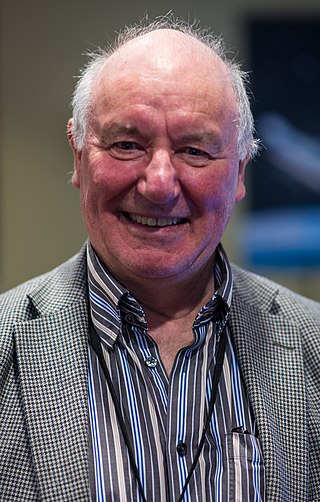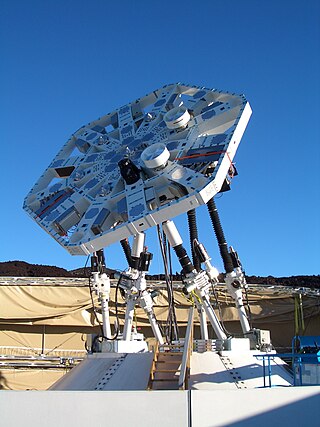
Astrophysics is a science that employs the methods and principles of physics and chemistry in the study of astronomical objects and phenomena. As one of the founders of the discipline, James Keeler, said, astrophysics "seeks to ascertain the nature of the heavenly bodies, rather than their positions or motions in space—what they are, rather than where they are", which is studied in celestial mechanics.

Typhoon Lee is an astrophysicist and geochemist at Academia Sinica, Taiwan, where he specializes in isotope geochemistry and nuclear astrophysics.

Malcolm Sim Longair is a British physicist. From 1991 to 2008 he was the Jacksonian Professor of Natural Philosophy in the Cavendish Laboratory at the University of Cambridge. Since 2016 he has been Editor-in-Chief of the Biographical Memoirs of Fellows of the Royal Society.

Richard Salisbury Ellis is Professor of Astrophysics at the University College London. He previously served as the Steele Professor of Astronomy at the California Institute of Technology (Caltech). He was awarded the 2011 Gold Medal of the Royal Astronomical Society, in 2022 the Royal Medal of the Royal Society and in 2023 the Gruber Prize in Cosmology.

The Physical Research Laboratory is a National Research Institute for space and allied sciences, supported mainly by Department of Space, Government of India. This research laboratory has ongoing research programmes in astronomy and astrophysics, atmospheric sciences and aeronomy, planetary and geosciences, Earth sciences, Solar System studies and theoretical physics. It also manages the Udaipur Solar Observatory and Mount Abu InfraRed Observatory. The PRL is located in Ahmedabad.

Robert P. Kirshner is an American astronomer, Chief Program Officer for Science for the Gordon and Betty Moore Foundation, and the Clownes Research Professor of Science at Harvard University. Kirshner has worked in several areas of astronomy including the physics of supernovae, supernova remnants, the large-scale structure of the cosmos, and the use of supernovae to measure the expansion of the universe.
Peter Coles is a theoretical cosmologist at Maynooth University. He studies the large scale structure of our Universe.
Astroparticle physics, also called particle astrophysics, is a branch of particle physics that studies elementary particles of astrophysical origin and their relation to astrophysics and cosmology. It is a relatively new field of research emerging at the intersection of particle physics, astronomy, astrophysics, detector physics, relativity, solid state physics, and cosmology. Partly motivated by the discovery of neutrino oscillation, the field has undergone rapid development, both theoretically and experimentally, since the early 2000s.

George Fitzgerald Smoot III is an American astrophysicist, cosmologist, Nobel laureate, and the second contestant to win the $1 million prize on Are You Smarter than a 5th Grader?. He won the Nobel Prize in Physics in 2006 for his work on the Cosmic Background Explorer with John C. Mather that led to the "discovery of the black body form and anisotropy of the cosmic microwave background radiation".

The Yuan-Tseh Lee Array for Microwave Background Anisotropy, also known as the Array for Microwave Background Anisotropy (AMiBA), is a radio telescope designed to observe the cosmic microwave background and the Sunyaev-Zel'dovich effect in clusters of galaxies. It is located on Mauna Loa in Hawaii, at 3,396 metres (11,142 ft) above sea level.

BICEP and the Keck Array are a series of cosmic microwave background (CMB) experiments. They aim to measure the polarization of the CMB; in particular, measuring the B-mode of the CMB. The experiments have had five generations of instrumentation, consisting of BICEP1, BICEP2, the Keck Array, BICEP3, and the BICEP Array. The Keck Array started observations in 2012 and BICEP3 has been fully operational since May 2016, with the BICEP Array beginning installation in 2017/18.

Maw-Kuen Wu is a Taiwanese physicist specializing in superconductivity, low-temperature physics, and high-pressure physics. He was a professor of physics at University of Alabama in Huntsville, Columbia University, and National Tsing Hua University, the Director of the Institute of Physics at Academia Sinica, the President of National Dong Hwa University, and is currently a distinguished research fellow of the Institute of Physics, Academia Sinica, and international member of National Academy of Sciences.
Marc Kamionkowski is an American theoretical physicist and currently the William R. Kenan, Jr. Professor of Physics and Astronomy at Johns Hopkins University. His research interests include particle physics, dark matter, inflation, the cosmic microwave background and gravitational waves.

The Academia Sinica Institute of Astronomy and Astrophysics is an affiliated research institute of Academia Sinica in Taipei.

Hiranya Vajramani Peiris is a British astrophysicist at the University of Cambridge, where she holds the Professorship of Astrophysics (1909). She is best known for her work on the cosmic microwave background radiation, and interdisciplinary links between cosmology and high-energy physics. She was one of 27 scientists who received the Breakthrough Prize in Fundamental Physics in 2018 for their "detailed maps of the early universe".

The Greenland Telescope is a radio telescope situated at the Thule Air Base in north-western Greenland. It will later be deployed at the Summit Station research camp, located at the highest point of the Greenland ice sheet at an altitude of 3,210 meters.

Renée Hložek is a South African cosmologist, Professor of Astronomy & Astrophysics at the Dunlap Institute for Astronomy & Astrophysics at the University of Toronto, and an Azrieli Global Scholar within the Canadian Institute for Advanced Research. She studies the cosmic microwave background, Type Ia supernova and baryon acoustic oscillations. She was named a Sloan Research Fellow in 2020, and received the Rutherford Memorial Medal from the Royal Society of Canada. Hložek identifies as bisexual.

Enoch Wu is a Taiwanese politician and businessman. Wu is the founder of Forward Alliance, a Taiwanese NGO focusing on national security.
You-Hua Chu is a Taiwanese astronomer. She has served as the director of the Institute of Astronomy and Astrophysics, Academia Sinica and the chair of the Department of Astronomy at the University of Illinois at Urbana-Champaign. Her main research areas are interactions between the interstellar medium and stars and observations of planetary systems in the post main sequence stages.















